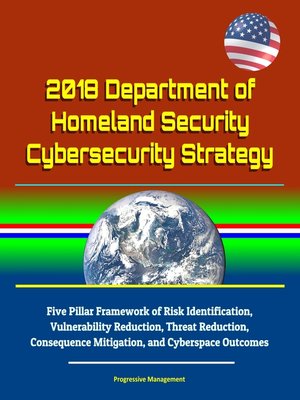2018 Department of Homeland Security Cybersecurity Strategy
ebook ∣ Five Pillar Framework of Risk Identification, Vulnerability Reduction, Threat Reduction, Consequence Mitigation, and Cyberspace Outcomes

Sign up to save your library
With an OverDrive account, you can save your favorite libraries for at-a-glance information about availability. Find out more about OverDrive accounts.
Find this title in Libby, the library reading app by OverDrive.



Search for a digital library with this title
Title found at these libraries:
| Loading... |
This excellent report has been professionally converted for accurate flowing-text e-book format reproduction.
The American people are increasingly dependent upon the Internet for daily conveniences, critical services, and economic prosperity. substantial growth in internet access and networked devices has facilitated widespread opportunities and innovation. This extraordinary level of connectivity, however, has also introduced progressively greater cyber risks for the united states. Long-standing threats are evolving as nation-states, terrorists, individual criminals, transnational criminal organizations, and other malicious actors move their activities into the digital world. Enabling the delivery of essential services—such as electricity, finance, transportation, water, and health care—through cyberspace also introduces new vulnerabilities and opens the door to potentially catastrophic consequences from cyber incidents. The growing number of internet-connected devices and reliance on global supply chains further complicates the national and international risk picture. More than ever, cybersecurity is a matter of homeland security and one of the core missions of the U.S. Department of Homeland Security (DHS).
This strategy provides the Department with a framework to execute our cybersecurity responsibilities during the next five years to keep pace with the evolving cyber risk landscape by reducing vulnerabilities and building resilience; countering malicious actors in cyberspace; responding to incidents; and making the cyber ecosystem more secure and resilient.
Contents * INTRODUCTION * Scope * The Cyber Threat * Managing National Cybersecurity Risk * Guiding Principles * Development and Implementation * PILLAR I - RISK IDENTIFICATION * Goal 1: Assess Evolving Cybersecurity Risks * PILLAR II - VULNERABILITY REDUCTION * Goal 2: Protect Federal Government Information Systems * Goal 3: Protect Critical Infrastructure * PILLAR III: THREAT REDUCTION * Goal 4: Prevent and Disrupt Criminal Use of Cyberspace * PILLAR IV - CONSEQUENCE MITIGATION * Goal 5: Respond Effectively to Cyber Incidents * PILLAR V - ENABLE CYBERSECURITY OUTCOMES * Goal 6: Strengthen the Security and reliability of the Cyber Ecosystem * Goal 7: Improve Management of DHS Cybersecurity Activities * CONCLUSION






